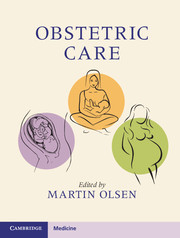Book contents
- Obstetric Care
- Obstetric Care
- Copyright page
- Dedication
- Contents
- Contributors
- Preface
- Chapter 1 Normal Labor
- Chapter 2 Abnormal Labor
- Chapter 3 Induction and Augmentation of Labor
- Chapter 4 Placental Abnormalities
- Chapter 5 Management of Obstetric Umbilical Cord Complications
- Chapter 6 Operative Vaginal Delivery
- Chapter 7 Cesarean Section
- Chapter 8 Cesarean Delivery Complications and Cesarean Hysterectomy
- Chapter 9 Vaginal Birth after Cesarean
- Chapter 10 Shoulder Dystocia
- Chapter 11 Perineal Trauma after Vaginal Delivery: Third and Fourth Degree Lacerations and Hematomas
- Chapter 12 Obstetric Anesthesia
- Chapter 13 Intrapartum Fetal Monitoring
- Chapter 14 Obstetric Ultrasound for the Generalist Obstetrician
- Chapter 15 Prenatal Diagnosis
- Chapter 16 Genetics
- Chapter 17 Abnormal Fetal Growth
- Chapter 18 Alloimmunization and Non-immune Hydrops Fetalis
- Chapter 19 Fetal Anomalies
- Chapter 20 Malpresentation
- Chapter 21 Intraamniotic Infection
- Chapter 22 Multifetal Pregnancy
- Chapter 23 Premature Rupture of Fetal Membranes Preterm and at Term
- Chapter 24 Preterm Delivery
- Chapter 25 Second Trimester Pregnancy Loss
- Chapter 26 Third Trimester Fetal Loss
- Chapter 27 Antepartum Hemorrhage
- Chapter 28 Postpartum Hemorrhage
- Chapter 29 Postpartum Infection
- Chapter 30 The Obstetric Patient with Trauma
- Chapter 31 Post-term Pregnancy
- Chapter 32 Musculoskeletal Disorders
- Chapter 33 Obesity in Pregnancy
- Chapter 34 Nausea and Vomiting of Pregnancy and Hyperemesis Gravidarum
- Chapter 35 Hypertension in Pregnancy
- Chapter 36 Cardiovascular Disease in Pregnancy
- Chapter 37 Pulmonary Disease in Pregnancy
- Chapter 38 Neurological Disease Complicating Pregnancy
- Chapter 39 Renal Diseases in Pregnancy
- Chapter 40 Hematologic Diseases Complicating Pregnancy
- Chapter 41 Gastrointestinal Disorders in Pregnancy
- Chapter 42 Selected Endocrine Disorders in Pregnancy
- Chapter 43 Diabetes Mellitus in Pregnancy
- Chapter 44 Connective Tissue Disorders and Pregnancy
- Chapter 45 Dermatologic Disorders and Pregnancy
- Chapter 46 Selected Infectious Diseases
- Chapter 47 Human Immunodeficiency Virus Infection and Pregnancy
- Chapter 48 Psychiatric Diseases in Pregnancy and the Postpartum Period
- Chapter 49 Substance Use in Women and Pregnancy
- Chapter 50 Cancer in Pregnancy
- Chapter 51 Thromboembolic Complications of Pregnancy
- Chapter 52 Disability in Pregnancy
- Chapter 53 The History of Obstetrics
- Index
- References
Chapter 13 - Intrapartum Fetal Monitoring
Published online by Cambridge University Press: 29 September 2017
- Obstetric Care
- Obstetric Care
- Copyright page
- Dedication
- Contents
- Contributors
- Preface
- Chapter 1 Normal Labor
- Chapter 2 Abnormal Labor
- Chapter 3 Induction and Augmentation of Labor
- Chapter 4 Placental Abnormalities
- Chapter 5 Management of Obstetric Umbilical Cord Complications
- Chapter 6 Operative Vaginal Delivery
- Chapter 7 Cesarean Section
- Chapter 8 Cesarean Delivery Complications and Cesarean Hysterectomy
- Chapter 9 Vaginal Birth after Cesarean
- Chapter 10 Shoulder Dystocia
- Chapter 11 Perineal Trauma after Vaginal Delivery: Third and Fourth Degree Lacerations and Hematomas
- Chapter 12 Obstetric Anesthesia
- Chapter 13 Intrapartum Fetal Monitoring
- Chapter 14 Obstetric Ultrasound for the Generalist Obstetrician
- Chapter 15 Prenatal Diagnosis
- Chapter 16 Genetics
- Chapter 17 Abnormal Fetal Growth
- Chapter 18 Alloimmunization and Non-immune Hydrops Fetalis
- Chapter 19 Fetal Anomalies
- Chapter 20 Malpresentation
- Chapter 21 Intraamniotic Infection
- Chapter 22 Multifetal Pregnancy
- Chapter 23 Premature Rupture of Fetal Membranes Preterm and at Term
- Chapter 24 Preterm Delivery
- Chapter 25 Second Trimester Pregnancy Loss
- Chapter 26 Third Trimester Fetal Loss
- Chapter 27 Antepartum Hemorrhage
- Chapter 28 Postpartum Hemorrhage
- Chapter 29 Postpartum Infection
- Chapter 30 The Obstetric Patient with Trauma
- Chapter 31 Post-term Pregnancy
- Chapter 32 Musculoskeletal Disorders
- Chapter 33 Obesity in Pregnancy
- Chapter 34 Nausea and Vomiting of Pregnancy and Hyperemesis Gravidarum
- Chapter 35 Hypertension in Pregnancy
- Chapter 36 Cardiovascular Disease in Pregnancy
- Chapter 37 Pulmonary Disease in Pregnancy
- Chapter 38 Neurological Disease Complicating Pregnancy
- Chapter 39 Renal Diseases in Pregnancy
- Chapter 40 Hematologic Diseases Complicating Pregnancy
- Chapter 41 Gastrointestinal Disorders in Pregnancy
- Chapter 42 Selected Endocrine Disorders in Pregnancy
- Chapter 43 Diabetes Mellitus in Pregnancy
- Chapter 44 Connective Tissue Disorders and Pregnancy
- Chapter 45 Dermatologic Disorders and Pregnancy
- Chapter 46 Selected Infectious Diseases
- Chapter 47 Human Immunodeficiency Virus Infection and Pregnancy
- Chapter 48 Psychiatric Diseases in Pregnancy and the Postpartum Period
- Chapter 49 Substance Use in Women and Pregnancy
- Chapter 50 Cancer in Pregnancy
- Chapter 51 Thromboembolic Complications of Pregnancy
- Chapter 52 Disability in Pregnancy
- Chapter 53 The History of Obstetrics
- Index
- References
- Type
- Chapter
- Information
- Obstetric Care , pp. 116 - 125Publisher: Cambridge University PressPrint publication year: 2017



